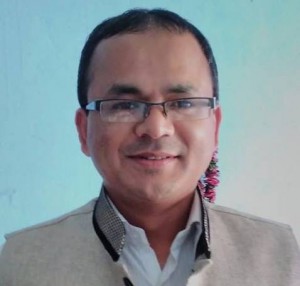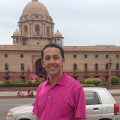
Introduction
Nepal is a multiethnic, multilingual, multi-religious and multicultural country. According to the latest census (2011), there are 123 languages and 125 castes and ethnic groups. However, Lewis (2009) and Yonjan-Tamang (2005) claim that there are 126 and 144 languages spoken within the territory of Nepal (as cited in Rai, Rai, Phyak & Rai, 2011). Although, languages are sources of knowledge and icon of identity, the majority of indigenous languages spoken in Nepal are endangered due to various reasons.
There were recorded ten different religions viz. Hindu, Bouddha, Islam, Kirat, Christian, Prakriti, Bon, Jain, Bahai and Sikha. Similarly, there are four llanguage families/genetic: Tibeto-burman, Indio-Aryan, Austro-Asiatic/Munda, Dravidian (Kansakar, 1996, p.1). But Rai (2016) says there five families (Kusunda no family ye), fourteen scripts.
According to (CBC, 2011), the major five mother tongue speakers are as follow:
| 1. | Nepali | 44.6% |
| 2. | Maithali | 11.7% |
| 3. | Bhojpuri | 6% |
| 4. | Tharu | 5.8% |
| 5. | Tamang | 5.1% |
| 6. | Newar | 3.2% |
According to Yadav (2007) many indigenous languages of Nepal have spoken form only. Rai (2016) says there are 14 scripts: 1. Nepali 2. Lepcha 3. Kirati 4. Tamang 5. Sherpa 6. Newari 7. Santhal 8. Gurung 9. Maithali 10. Bhojpuri 11. Magar 12. Sunuwar (Koich) 13. Dhimal 14. Muslim (Urdu)
According to Yadav (2007,10) Awadhi, Bhojpuri, Hindi, Maithli, Newari, Sherpa, Tamang, Tharua and Urdu have all kinds of publications, whereas Bajjika, Chepang, Danuwar, Jero, Kumal, Lohorung, Nawa, Nuhbri Ke (Larke), Santhali (Satar), Surel, Tokpegola/Dhokpya and Uranw/Kudux have no publications and other languages have some publications available.
Language Planning and Methodology
Language planning is inevitable for any government since it is associated with the notion of national language. Language as an identity can be a source of national unification as well as source of dispute in a country. Therefore, in the multilingual situation like in Nepal, proper initiative needs to be adopted to build a unified nation.
For the first time, the term ‘language planning’ was coined by Einar Haugen in the 1950s to elucidate the process of language development. It is “a government-authorized, long-term, sustained and conscious effort to alter a language’s function in a society for the purpose of solving communication problems” (Weinstein, 1980, p. 56.). Conclusively, following Cooper (1989) it can be understood as deliberate efforts to influence the behaviour of others with respect to the acquisition, structure, or functional allocation of their language codes” (p. 183). Mostly, language planning is carried out by authorized agencies but to restrict it to the work of authoritative institutions is to be too restrictive (Cooper, 1989).
Different scholars suggest different stages of language planning. Such as, Haugen (1966) proposes four aspects of language development: selection of form, codification of form, elaboration of function and acceptance by the community. On the other hand, Cooper (1989) suggests three stages of language planning: corpus planning, status planning, and acquisition planning. The stages mentioned by Cooper (1989) can be described as follows:
Corpus planning
Corpus planning deals with the reform within the language structure. Most commonly, a language or one variety of a language is picked up by the government to standardize it. Cooper (1989) states it as the “the creation of new forms, the modification of old ones, or the selection from alternative forms in a spoken or written code” (p. 31). It focuses on the internal condition of a language or language variety. It aims to standardize a variety of language and change its condition. It generally includes the development of orthography, new sources of vocabulary, dictionaries, and literature, and the deliberate cultivation of new uses so that the use of language can be extended to government, education, trade and link language and so on. It may include creation of new forms in spelling, pronunciation, vocabulary, and grammar. As Corpus Planning of Nepali language, British Scholars such as J.A. Ayton (1820) and Sir Ralph Turner (1931) began the standardization process by producing grammar and dictionaries of Nepali. (Kansakar 1996, p.3)
Status planning
Status planning changes the status of a language either by raising or degrading the status of a language. It may deprive or allow the speakers of a minority language to use it in government, education, and trade. It deals with efforts undertaken to change the use and function of a language. It is the allocation of new function to the language in question. Conclusively, for Cooper (1989) it refers to ‘changes in the systems of … speaking’, ‘changes in a language’s functions, ‘language use’, ‘use of language’ and ‘organization of a community’s language resources’. It is concerned with the relationship between language rather than changes within them.
Acquisition planning
It aims to expand the number of speakers of the language in question. Following Cooper (1989) “When planning is directed towards increasing a language’s uses, it falls within the rubric of status planning” (p. 33). It focuses on the teaching and the use of language. Cooper (1989) mentions three types of acquisition goals:
- Acquisition of the language as the second or foreign language;
- Renativization or revitalization of the language;
- Language maintenance.
In case of acquisition planning, the learners are provided with opportunities and incentives to attract their attention. Acquisition planning becomes effective when the language in question serves all the functions desired by the speakers or learners.
Phases of Language Planning in Nepal
Weinberg (2013, p.63) has mentioned three phases of language planning in Nepal.
Periods before 1950 (As rare as snakes in Ireland)
This phase is considered to begin around the annexation of Nepal by Prithivi Narayan Shah and existed till 1950. It stretched within two absolute reigns of Nepal, absolute Shah before Ranarchy and Ranarchy itself. The use of then Khasa language has become Nepali language now which was supposed to germinate politically during Shah Regime in Gorkha. This very language was nurtured by Ranas later. However, “The Rana rulers were not interested in developing the feelings of nationalism that often inspire the imposition of national language policies” (Burghart, 1984 in Weinberg 2013, p.63). They were also opposed to widespread education therefore there was no need to set language in education policies.
First language policy in Nepal was made in 1905. Then, Nepali language was made as language of law and government. However, Hutt (1988 in Weinberg 2013, p.63) claims that no documentation of this declaration has been published.
On the other hand, though Nepali was only permissible court language, Rana (Janga Bahadur) wanted English-language education for his children. He established Durbar School for Rana family. It was the first government-run English medium school in Nepal. However, Hindu Pathshalas and Baudha Gompas were using Sanskrit and Tibetan respectively as medium of instruction from the time immemorial in Nepal.
Later, Dev Shamsher opened 200 Nepali language schools. Likewise, in 1905 Chandra Shamsher started a Nepali-medium school to train civil servants. In 1934, Nepali was declared as the official language of education (Caddell, 2007 in Weinberg, 2013, p. 69).
Padam Shamsher’s regime is marked as a turning point in the history of language policy of Nepal. He proposed ‘vernacular’ schools inspired by Gandhi.
The first post-secondary educational institution in Nepal was Trichandra College, established in 1918. In this college, language of education was English. Its purpose was to shelter students of Durbar school and to prevent them from going abroad (India). His underling purpose was to prevent Nepalese from getting radical ideas which could be dangerous for them.
From 1950-1990 (Panchayat Era: one language one nation)
After 1950 for the first time, Nepal’s government became interested in cultural unification. According to Rai et al. (2011) Panchayat government imposed their political goals through the slogan of ek bhasha, ek bhesh, ek dharma, ek desh (one language, one way of dress, one religion, one nation), which attempted to spread Nepali, Hinduism, and other symbols of nation throughout the country to create a unified national identity. Its goal was to assimilate people of different culture and linguistic background into a Nepali identity based on the cultural practices of elite, high-caste hill Hindus (Onta, 1996a, as cited in Weinberg 2013)
Education was taken as a tool for teaching the end. After the introduction of democracy, new educational language policy was formed considering the recommendation of Nepal National Educational Planning Commission (NNEPC). The report of the NNEPC strongly supported Nepali as the medium of instruction for schooling, largely for purposes of national integration. The report advocated the use of Nepali language not only in classroom but also on playgrounds and in all spheres of life. It states:
The study of a non-Nepali local tongue would mitigate against the effective development of Nepali, for the student would make greater use of it than Nepali – at home and in the community – and thus Nepali would remain a “foreign” language. If the younger generation is taught to use Nepali as the basic language, then other languages will gradually disappear, and greater national strength and unity will result. (NNEPC, 1956, p. 97).
NNEP followed Hugh B. Wood’s personal view and practice of his country (English as medium). Another educational policy was proposed by National Education System Plan (NESP,1971). It advocated the use of only Nepali in administration, education and media. Stressing the need of monolingual situation, it states the goal of education as”
“to strength devotion to crown, country, national unity and the Panchayat system, to develop uniform traditions in education by bringing together various patterns under a single national policy, to limit the tradition of regional languages…” (Ministry of Education, 1971, p.1)
Throughout Panchayat era Nepali language speakers got privilege as the goal of education was to unify nation under one language and one culture.
Schooling After 1990: The Right to Education in the Mother Tongue
After the restoration of democracy in 1990, for the first time new constitution recognized Nepal as a multicultural and multilingual country. The Constitution of 1990 states “All the languages spoken as the mother tongue in the various parts of Nepal are the national languages of Nepal. (His Majesty’s Government of Nepal, 1990). For the first time language in education policy was stated in the constitution. It paved a way for running school in mother-tongue and even teaching at least up to primary in mother tongue.
In 1993 a commission for formulating policy for national languages was formed to promote national languages and their use in local administration, primary education and media.
Rai (2016) claims that as a result of ‘Education for all (2015) campaign’, textbooks are published in twenty two indigenous languages. Quite recently, the constitution of Nepal (2015) has provisioned the right of language under fundamental rights and states, “Every Nepalese community residing in Nepal shall have the right to get education in its mother tongue and, for that purpose, to open and operate schools and educational institutes, in accordance with law. (The Constitution of Nepal, 2015, Part 3, Article 31)
The School Sector Reform Plan, 2009-2015 provided supported use of mother tongues in grade one through three (Ministry of Education, 2009). The government has approved a set of guidelines for implementing multilingual education and commissioned a report on teaching Nepali as a second language to speakers of other languages in Nepal (Yonjan-Tamang, 2012 in Weinberg, 2013, p.67).
Conclusion
Language planning tries to develop the uses of the country’s national language for the purposes of education, trade, technology and so on. Language planning is ideally based on language policy. Language planning mainly embraces corpus planning, status planning and acquisition planning. In the history of language planning in Nepal has gone through many ups and downs, from monolingualism to mother-tongue rights which still lack feasibility and ground based reality in planning and implementation. Since it is the era of local identity, the government has accepted its spirit through linguistic inclusion.
Kumar Narayan Shrestha, M.Ed. and M.A., is a faculty at Tribhuvan University, Nepal. He is an M.Phil. scholar at Kathmandu University. He has been associated in teaching for seventeen years. He has published articles in different journals and presented papers in national/international conferences. His professional interests include ELT, research and translation.
References
Central Bureau of Statistics. (2014). Statistical pocket book of Nepal. Kathmandu: Author.
Nepal Gazette (2015). The Constitution of Nepal (2015). Kathmandu: Author.
His Majesty’s Government, Nepal. (1990). Constitution of the Kingdom of Nepal 2047 (1990). Kathmandu: His Majesty’s Government.
Kansakar, T.R. (1996). Language planning and modernization in Nepal. Nepalese Linguistics, 13 .1-13.
Ministry of Education. (1971). The national education system plan for 1971-76. Kathmandu: His Majesty’s Government.
Nepal National Education Planning Commission. (1956). Education in Nepal: Report of the Nepal education planning commission. Kathmandu: His Majesty’s Government.
Rai, G. (2016, August 26). Ojnelma chaltika anya lipi [Other prevalent scripts in shadow]. Kantipur, p. 11.
Rai, V.S., Rai, M., Phyak, P. Rai, N. (2011). Multilingual education in Nepal: Hearsay and reality? A report. Paper commissioned for UNESCO. Kathmandu: UNESCO.
Weinberg, M. (2013). Revisiting history in language policy: The case of medium of instruction in Nepal. Working Paper in Educational Linguistics, 28 (1), 61-80.
Weinstein, B. (1980). Language planning in francophone Africa. LPLP, 4 (1), 55-77.
Yadava, Y.P. (2007). Linguistic diversity in Nepal perspectives on language policy. Retrieved from https://www.researchgate.net/publication/ 237459920



 Babu Ram Basnet Mahendrodaya Secondary School, Salyan, Solukhumbu
Babu Ram Basnet Mahendrodaya Secondary School, Salyan, Solukhumbu Chandra Singh Dhami Manthali Higher Secondary School, Manthali, Ramechhap
Chandra Singh Dhami Manthali Higher Secondary School, Manthali, Ramechhap Kamal Raj Basyal Krishna secondary school, Peepaldada-Jheskang, Palpa
Kamal Raj Basyal Krishna secondary school, Peepaldada-Jheskang, Palpa  Durga Prasad Pandeya Padmodaya Public Model Secondary School, Ghorahi, Dang
Durga Prasad Pandeya Padmodaya Public Model Secondary School, Ghorahi, Dang Khagendra Nath ‘Biyogi’ Bhairab Higher Secondary School, Jhota, Bajhang
Khagendra Nath ‘Biyogi’ Bhairab Higher Secondary School, Jhota, Bajhang